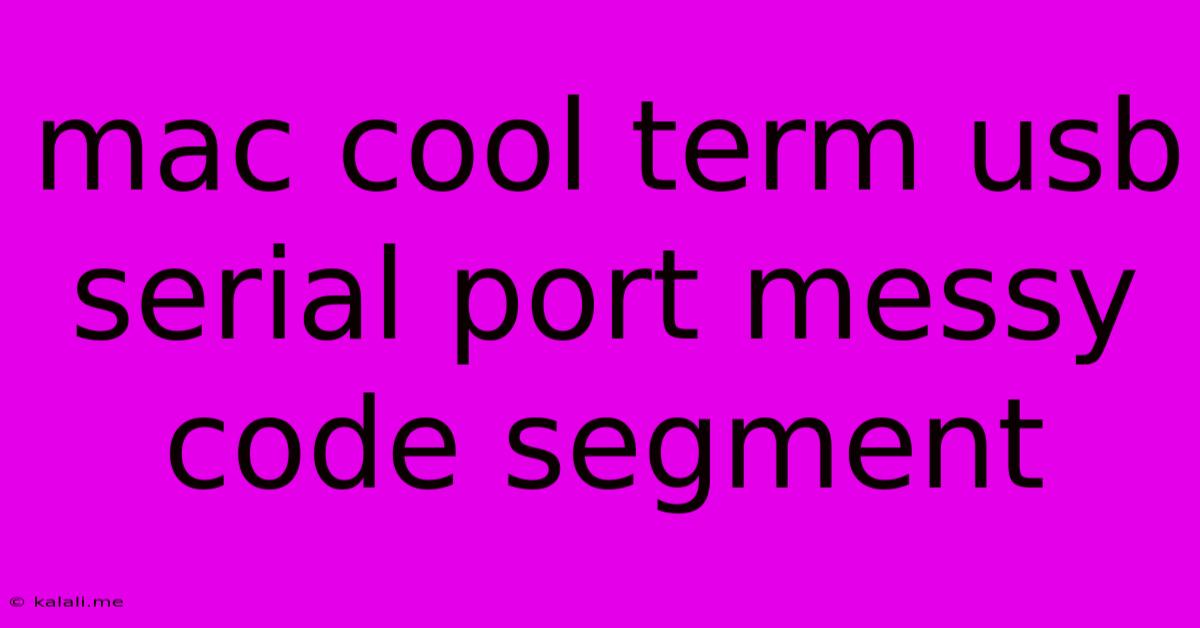Mac Cool Term Usb Serial Port Messy Code Segment
Kalali
May 30, 2025 · 3 min read

Table of Contents
Decoding the Mess: Understanding and Cleaning Up Mac Cool Term USB Serial Port Code
Working with serial communication on a Mac using CoolTerm often involves navigating less-than-ideal code segments. This article dives into common issues encountered when using CoolTerm's USB serial port functionality, explaining why the code might look "messy," and offering strategies for cleaning it up for better readability, maintainability, and ultimately, more robust applications. This guide is particularly useful for developers working on projects involving data acquisition, embedded systems control, or any application requiring direct serial communication.
Why Serial Port Code Can Seem Messy
Several factors contribute to the perceived "messiness" of code interacting with CoolTerm's USB serial port:
-
Asynchronous Nature of Serial Communication: Serial communication is inherently asynchronous. Data arrives unpredictably, leading to code that often incorporates interrupts, callbacks, or polling mechanisms to handle incoming data efficiently. This asynchronous nature can make the code flow appear less linear and more complex than synchronous operations.
-
Error Handling: Robust serial communication requires thorough error handling. Dealing with potential issues like buffer overflows, communication timeouts, and hardware failures necessitates conditional statements and exception handling, adding to the code's apparent complexity.
-
Hardware-Specific Details: The specifics of your USB-to-serial adapter and the connected device significantly influence the code. Baud rates, data bits, parity, and stop bits must be correctly configured, which adds lines of code dedicated to initialization and parameter setting.
-
Legacy Code: Older code might lack modern coding practices like modular design or consistent naming conventions. This can make understanding and modifying the code challenging.
Common Code Issues and Solutions
Here are some frequent problems and practical solutions for cleaning up your CoolTerm USB serial port code:
-
Lack of Comments: Adequate comments are crucial. Explain the purpose of each code section, variable, and function call. This makes your code significantly easier to understand for both yourself and others.
-
Inconsistent Formatting: Adopt a consistent coding style guide (e.g., PEP 8 for Python). This includes consistent indentation, naming conventions, and spacing. Proper formatting dramatically improves readability.
-
Long Functions: Break down large functions into smaller, more manageable units. This improves code modularity, readability, and testability.
-
Global Variables: Minimize the use of global variables. Favor passing data as arguments to functions, enhancing code clarity and reducing potential conflicts.
-
Inefficient Error Handling: Implement comprehensive and structured error handling. Use try-except blocks (or similar mechanisms depending on your programming language) to catch potential exceptions and handle them gracefully.
-
Unclear Variable Names: Use descriptive variable names that clearly indicate their purpose. Avoid cryptic abbreviations or single-letter names.
-
Magic Numbers: Replace hardcoded values (e.g., baud rates) with named constants. This improves code readability and makes it easier to modify the settings in the future.
Example of Improved Code Structure (Conceptual Python)
Let's imagine a snippet of messy code and its improved version. This is conceptual and will need adaptation based on your specific hardware and CoolTerm setup.
Messy Code (Conceptual):
ser = serial.Serial('/dev/tty.usbmodem1411', 9600) # No comments, magic number
data = ser.readline()
if data:
print(data)
process_data(data) # Function undefined, unclear what it does
else:
print("No data")
ser.close()
Improved Code (Conceptual):
import serial
BAUD_RATE = 9600
SERIAL_PORT = '/dev/tty.usbmodem1411'
def process_incoming_data(data):
"""Processes the received serial data."""
# Add your data processing logic here
print(f"Received data: {data.decode()}") #Improved clarity
try:
with serial.Serial(SERIAL_PORT, BAUD_RATE) as ser:
while True: # Simplistic example, adapt for your application
data = ser.readline()
if data:
process_incoming_data(data)
else:
print("Timeout or no data received.")
except serial.SerialException as e:
print(f"Serial communication error: {e}")
except Exception as e:
print(f"An unexpected error occurred: {e}")
finally:
print("Exiting the serial communication loop")
By applying these principles, you can transform your seemingly messy CoolTerm USB serial port code into a more elegant, efficient, and maintainable solution. Remember that consistent refactoring and the use of best practices are key to building robust and understandable serial communication applications.
Latest Posts
Latest Posts
-
Java Home Should Point To A Jdk Not A Jre
May 31, 2025
-
Origin Of Clean As A Whistle
May 31, 2025
-
How Old Was Saul When Stephen Was Stoned
May 31, 2025
-
Long Press Showing Special Character But Not Repeating
May 31, 2025
-
Reset Usb Ports Mackbok Air With Terminal
May 31, 2025
Related Post
Thank you for visiting our website which covers about Mac Cool Term Usb Serial Port Messy Code Segment . We hope the information provided has been useful to you. Feel free to contact us if you have any questions or need further assistance. See you next time and don't miss to bookmark.